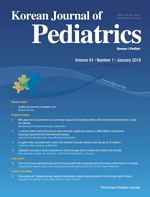Article Contents
| Clin Exp Pediatr > Volume 61(1); 2018 |
|
To the editor:
We read with great interest the recently published article by Choi et al.,1) which describes the first reported case of megalencephaly-capillary malformation-polymicrogyria syndrome in Korea. Megalencephaly-capillary malformation syndrome is a rare disorder characterized by megalencephaly or hemimegalencephaly, focal or generalized somatic overgrowth, and vascular malformations. We have some minor concerns regarding the report.
First, capillary malformation (CM) is a major criterion according to Wright et al.2) and Martínez-Glez et al.,3) and a core feature, according to Mirzaa et al.4) In Table 1 in their report, the authors examined the patient for CM. Although CMs tend to darken and thicken with time, they are usually pinkish red to purple in color.5) We wonder whether the patient had an obvious CM, except multiple telangiectasia, or brownish patches.
Second, we have reported a case entitled ‚ÄúMegalencephaly-capillary Malformation Syndrome‚ÄĚ in 2015.6) Although published in a Korean journal, the case can be searched through the KoreaMed Web site (https://www.koreamed.org/SearchBasic.php). The patient was an 11-month-old male infant who presented with extensive, diffuse, reticulated, erythematous patches on his face, trunk, and extremities. Histopathological findings from the erythematous patch on the chest showed slightly dilated capillaries in the upper part of the dermis. Physical examination revealed an increased head circumference (52 cm, >97th percentile), frontal bossing, hypertrophy of the right arm and leg, and syndactyly between the second and third toes of both feet. Borderline developmental delay was identified using the Korean Infant and Child Developmental Screening Test. Radiological findings showed asymmetry of the upper and lower extremities. Magnetic resonance imaging of the brain revealed an enlarged right cerebral hemisphere and nonobstructive ventriculomegaly. Although genetic testing was not performed, the patient was diagnosed with megalencephaly-capillary malformation syndrome based on clinical, radiological, and pathological findings.
Genetic testing, in addition to the clinical and radiological findings, could facilitate an accurate diagnosis. We agree with the authors' speculation in the discussion section of the report that genetic testing may provide clues for determining the underlying genetic etiology of this syndrome.
Notes
Conflicts of interest:
No potential conflict of interest relevant to this article was reported.
References
1. Choi YC, Yum MS, Kim MJ, Lee YJ, Ko TS. Megalencephaly-capillary malformation-polymicrogyria syndrome: the first case report in Korea. Korean J Pediatr 2016;59(Suppl 1): S152‚ÄďS156.



2. Wright DR, Frieden IJ, Orlow SJ, Shin HT, Chamlin S, Schaffer JV, et al. The misnomer ‚Äúmacrocephaly-cutis marmorata telangiectatica congenita syndrome‚ÄĚ: report of 12 new cases and support for revising the name to macrocephaly-capillary malformations. Arch Dermatol 2009;145:287‚Äď293.

3. Mart√≠nez-Glez V, Romanelli V, Mori MA, Gracia R, Segovia M, Gonz√°lez-Meneses A, et al. Macrocephaly-capillary malformation: analysis of 13 patients and review of the diagnostic criteria. Am J Med Genet A 2010;152A:3101‚Äď3106.


4. Mirzaa GM, Conway RL, Gripp KW, Lerman-Sagie T, Siegel DH, deVries LS, et al. Megalencephaly-capillary malformation (MCAP) and megalencephaly-polydactyly-polymicrogyria-hydrocephalus (MPPH) syndromes: two closely related disorders of brain overgrowth and abnormal brain and body morphogenesis. Am J Med Genet A 2012;158A:269‚Äď291.


5. Fitzpatrick TB, Goldsmith LA. Fitzpatrick's dermatology in general medicine. 8th ed. New York: McGraw-Hill Professional, 2012.
6. Park SM, Kim GW, Cho HH, Kim WJ, Mun JH, Song M, et al. Megalencephaly-capillary Malformation syndrome. Korean J Dermatol 2015;53:546‚Äď551.




 PDF Links
PDF Links PubReader
PubReader ePub Link
ePub Link PubMed
PubMed Download Citation
Download Citation


